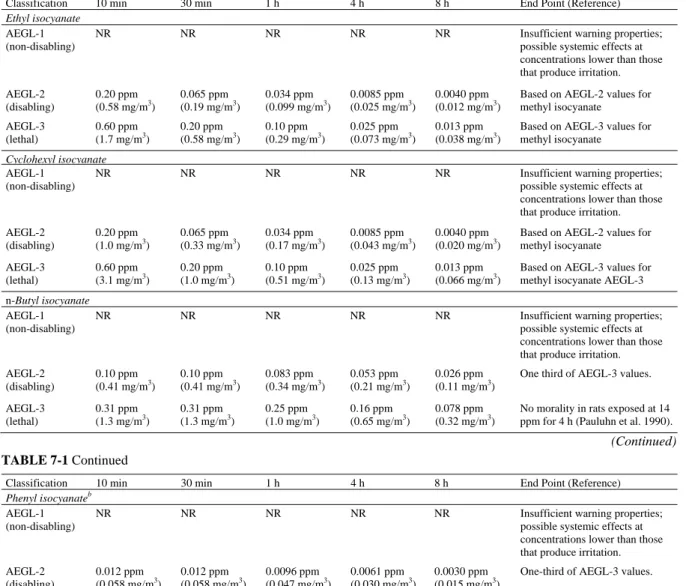1
急性曝露ガイドライン濃度 (AEGL)
Selected Monoisocyanates - n-Butyl isocyanate (111-36-4)
主要なモノイソシアネート - イソシアン酸 n-ブチル
Table AEGL 設定値
n-Butyl isocyanate 111-36-4 (Final)
ppm
10 min
30 min
60 min
4 hr
8 hr
AEGL 1
NR NR NR NR NR
AEGL 2
0.10 0.10 0.083 0.053 0.026
AEGL 3
0.31 0.31 0.25 0.16 0.078
NR: データ不十分により推奨濃度設定不可
設定根拠(要約):
ここでは、4 種類のモノイソシアナネート、すなわち、イソシアン酸エチル、イソシアン酸 n-ブ
チル、イソシアン酸シクロヘキシル、イソシアン酸フェニルについて、考察を行う。これら 4 種
類のモノイソシアネートは、イソシアン酸メチルが引き起こすものと同様の、遅延性致死などの
毒性影響を引き起こすと思われる。イソシアン酸メチルについては、警告特性が弱く、また、
AEGL-1 に相当する影響が生じる濃度より低い濃度で全身毒性が生じ得ることから、AEGL-1 値
は導出されていない(NRC 2003)。ここでとりあげたモノイソシアネートについても、イソシア
ン酸メチルとの類似性に基づいて、AEGL-1 値を導出しなかった。
イソシアン酸エチルおよびイソシアン酸シクロヘキシルに関するデータは、ラットを用いた致死
性試験のものに限られており、それらの試験では、被験動物数が少なく、実濃度が分析されてお
らず、ほぼすべての試験濃度で致死率が 100%であった。データが乏しいため、AEGL-2 値と
AEGL-3 値は、イソシアン酸メチルの AEGL 値に基づいた。これら 3 種類の化学物質について得
られた致死データの比較から、イソシアン酸メチルの値を代用し、イソシアン酸エチルおよびイ
ソシアン酸シクロヘキシルの方が毒性が強い可能性があることを考慮して修正係数 2 を適用する
ことで、十分に保護的な AEGL 値が得られることが示唆される。例えば、各群 3 匹ずつのラット
をイソシアン酸エチルに 6 時間曝露した試験では、27 ppm 群では全ラットが生存し、82 ppm 群
では生存ラットはいなかった。ラット 3 匹を 18 ppm のイソシアン酸シクロヘキシルに 6 時間曝
露した試験では、曝露後 7 日目に 1 匹が死亡し、残りはおそらく瀕死状態に陥ったため、8 日目
に屠殺された。そして、イソシアン酸メチルについては、ラットにおける 6 時間 LC
50(半数致死
濃度)は、6.1 ppm である(NRC 2003)。
イソシアン酸 n-ブチルおよびイソシアン酸フェニルの AEGL-3 値の導出には、適切なラットの致
2
死データが得られている。AEGL-2 値は、対応する AEGL-3 値の 3 分の 1 の値とした。イソシア
ン酸メチルで認められた種差が小さいことから、両化合物の AEGL-3 値の導出に際し、種間不確
実係数 3 を適用した。種内変動については、イソシアン酸メチルの場合(NRC 2003)にならい、
係数 10 を適用した。イソシアン酸メチルは発生毒性を示すことが知られているが、イソシアン
酸 n-ブチルおよびイソシアン酸フェニルについては、発生毒性を示す可能性について、データが
不足しているため、修正係数 3 も適用した。
ここで取り上げた主要なモノイソシアネートの AEGL 値を Table 7-1 に示す。比較のため、イソ
シアン酸メチルおよびジイソシアン酸トルエンの AEGL 値を Table 7-2 に示す。
TABLE 7-1 AEGL Values for Selected Monoisocyanates
aClassification 10 min 30 min 1 h 4 h 8 h End Point (Reference)
Ethyl isocyanate
AEGL-1 (non-disabling)
NR NR NR NR NR Insufficient warning properties;
possible systemic effects at concentrations lower than those that produce irritation. AEGL-2 (disabling) 0.20 ppm (0.58 mg/m3) 0.065 ppm (0.19 mg/m3) 0.034 ppm (0.099 mg/m3) 0.0085 ppm (0.025 mg/m3) 0.0040 ppm (0.012 mg/m3)
Based on AEGL-2 values for methyl isocyanate AEGL-3 (lethal) 0.60 ppm (1.7 mg/m3) 0.20 ppm (0.58 mg/m3) 0.10 ppm (0.29 mg/m3) 0.025 ppm (0.073 mg/m3) 0.013 ppm (0.038 mg/m3)
Based on AEGL-3 values for methyl isocyanate
Cyclohexyl isocyanate
AEGL-1 (non-disabling)
NR NR NR NR NR Insufficient warning properties;
possible systemic effects at concentrations lower than those that produce irritation. AEGL-2 (disabling) 0.20 ppm (1.0 mg/m3) 0.065 ppm (0.33 mg/m3) 0.034 ppm (0.17 mg/m3) 0.0085 ppm (0.043 mg/m3) 0.0040 ppm (0.020 mg/m3)
Based on AEGL-2 values for methyl isocyanate AEGL-3 (lethal) 0.60 ppm (3.1 mg/m3) 0.20 ppm (1.0 mg/m3) 0.10 ppm (0.51 mg/m3) 0.025 ppm (0.13 mg/m3) 0.013 ppm (0.066 mg/m3)
Based on AEGL-3 values for methyl isocyanate AEGL-3 n-Butyl isocyanate
AEGL-1 (non-disabling)
NR NR NR NR NR Insufficient warning properties;
possible systemic effects at concentrations lower than those that produce irritation. AEGL-2 (disabling) 0.10 ppm (0.41 mg/m3) 0.10 ppm (0.41 mg/m3) 0.083 ppm (0.34 mg/m3) 0.053 ppm (0.21 mg/m3) 0.026 ppm (0.11 mg/m3)
One third of AEGL-3 values.
AEGL-3 (lethal) 0.31 ppm (1.3 mg/m3) 0.31 ppm (1.3 mg/m3) 0.25 ppm (1.0 mg/m3) 0.16 ppm (0.65 mg/m3) 0.078 ppm (0.32 mg/m3)
No morality in rats exposed at 14 ppm for 4 h (Pauluhn et al. 1990).
(Continued)
TABLE 7-1 Continued
Classification 10 min 30 min 1 h 4 h 8 h End Point (Reference)
Phenyl isocyanateb AEGL-1 (non-disabling)
NR NR NR NR NR Insufficient warning properties;
possible systemic effects at concentrations lower than those that produce irritation. AEGL-2 (disabling) 0.012 ppm (0.058 mg/m3) 0.012 ppm (0.058 mg/m3) 0.0096 ppm (0.047 mg/m3) 0.0061 ppm (0.030 mg/m3) 0.0030 ppm (0.015 mg/m3)
One-third of AEGL-3 values.
AEGL-3 (lethal) 0.036 ppm (0.18 mg/m3) 0.036 ppm (0.18 mg/m3) 0.029 ppm (0.14 mg/m3) 0.018 ppm (0.088 mg/m3) 0.0091 ppm (0.044 mg/m3) 4-h BMCL05 of 1.64 ppm in rats (Bayer AG 1991a)
aWhen more than one of the monoisocyanates is detected at a scene, the lowest AEGL should be applied to the sum total concentration of all de-tected monoisocyanates because of a presumed common mode of action. On the basis of toxicity data on methyl isocyanate, it is plausible that ex-posure to these monoisocyanates might be associated with systemic toxicity at concentrations below those associated with irritation. Absence of AEGL-1 values does not imply that concentrations below AEGL-2 values are without effect.
bPhenyl isocyanate has shown dermal sensitizing effects. Its respiratory sensitizing potential is unknown. Individuals who have a strong reac-tion might not be protected within the definireac-tion of effects for each AEGL level.
Abbreviations: BMCL05, benchmark concentration, 95% confidence limit with a 5% response; MF, modifying factor; NR, not recommended; and UF, uncertainty factor.
3
TABLE 7-2 AEGL Values for Methyl Isocyanate and Toluene Diisocyanate
Classification 10 min 30 min 1 h 4 h 8 h
Methyl isocyanate AEGL-1a (nondisabling) NR NR NR NR NR AEGL-2 (disabling) 0.40 ppm (0.94 mg/m3) 0.13 ppm (0.32 mg/m3) 0.067 ppm (0.16 mg/m3) 0.017 ppm (0.034 mg/m3) 0.0080 ppm (0.020 mg/m3) AEGL-3 (lethal) 1.2 ppm (2.8 mg/m3) 0.40 ppm (0.95 mg/m3) 0.20 ppm (0.47 mg/m3) 0.050 ppm (0.12 mg/m3) 0.025 ppm (0.060 mg/m3)
Toluene 2,4- and 2,6-diisocyanate
AEGL-1 (nondisabling) 0.02 ppm (0.14 mg/m3) 0.02 ppm (0.14 mg/m3) 0.02 ppm (0.14 mg/m3) 0.01 ppm (0.07 mg/m3) 0.01 ppm (0.07 mg/m3) AEGL-2 (disabling) 0.24 ppm (1.71 mg/m3) 0.17 ppm (1.21 mg/m3) 0.083 ppm (0.59 mg/m3) 0.021 ppm (0.15 mg/m3) 0.021 ppm (0.15 mg/m3) AEGL-3 (lethal) 0.65 ppm (4.63 mg/m3) 0.65 ppm (4.63 mg/m3) 0.51 ppm (3.63 mg/m3) 0.32 ppm (2.28 mg/m3) 0.16 ppm (1.14 mg/m3) a

